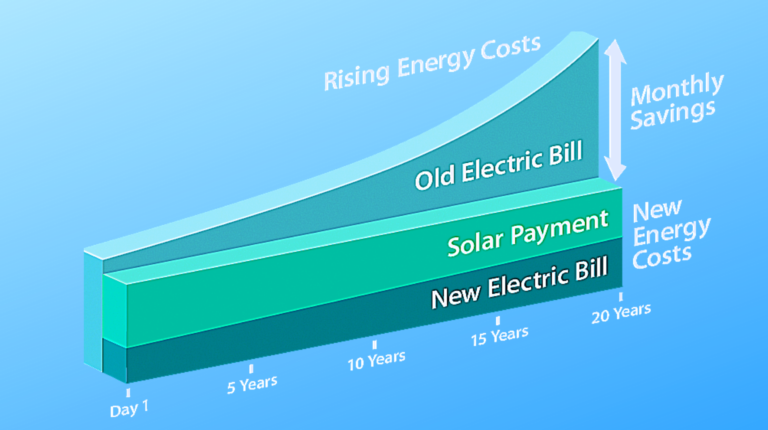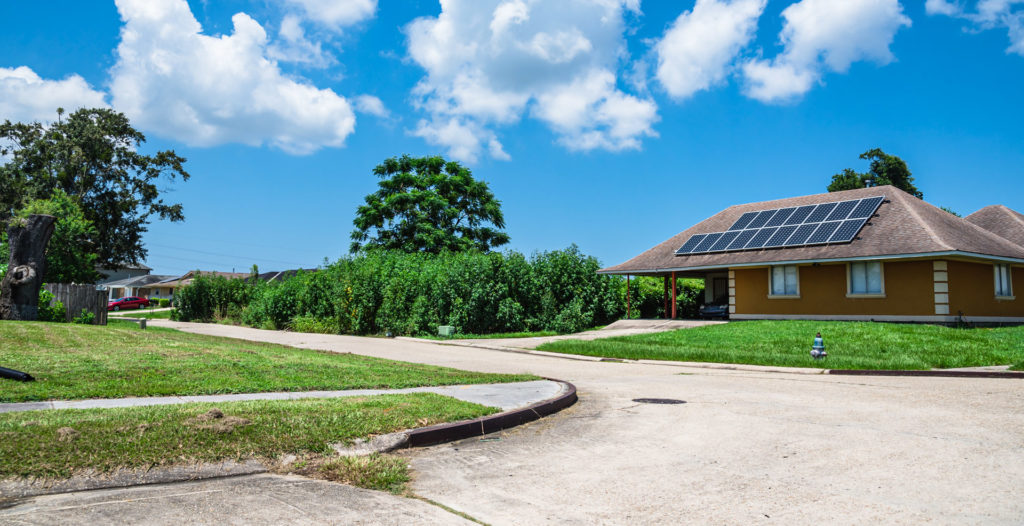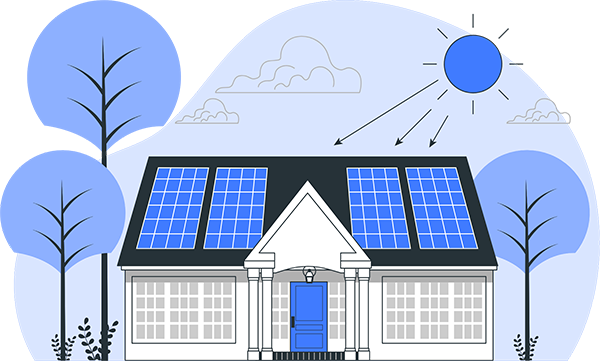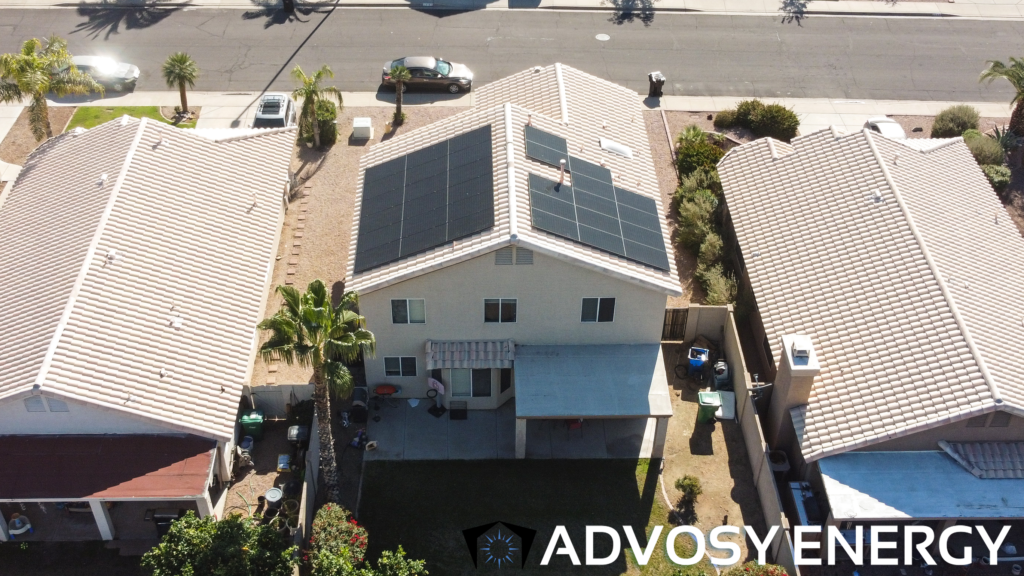As one of the sunniest cities in the United States, Phoenix, Arizona has long been a hotbed for renewable energy. With its year-round warmth and consistent sunshine, it’s no surprise that solar roofing is one of the most popular green energy sources in the area. But what impact does Phoenix’s unique climate have on solar roofing performance? In this article, we’ll explore how the weather conditions in Phoenix affect solar roofing performance and what homeowners can do to ensure their systems are running at peak efficiency.
The temperature extremes of summer and winter in Phoenix can take a toll on any type of roofing system, but especially solar roofs. Heat reflection off of metal roofs can cause problems with solar panels if they aren’t properly shaded or ventilated. Extreme heat can also cause electrical components to short out over time or even degrade the photovoltaic cells themselves. On the other hand, cold temperatures mean that there is less sunlight available for powering up your solar roof during winter months.
Overview Of Phoenix Climate
Phoenix is known for its hot, dry climate. The city is located in the Sonoran Desert, and temperatures average over 100 degrees Fahrenheit in the summer months. Rainfall is scarce and most of the precipitation comes during the monsoon season between July and September. This extreme heat, combined with its arid environment, presents a number of challenges to those living in Phoenix.
One of these challenges is the impact that the desert climate has on solar roofing performance. Solar roofs are designed to absorb sunlight and convert it into energy that can be used to power homes or businesses. High temperatures can cause solar panels to overheat, which significantly reduces their efficiency. In addition, dust storms are common in Phoenix, which can reduce the amount of sunlight reaching the solar panels and further decrease efficiency.
To combat this issue, homeowners must take steps to ensure their solar roofing systems are properly insulated and maintained in order to maximize their performance despite the harsh climate. Proper insulation helps keep temperatures low while regular maintenance can remove dust particles from solar panels so they are able to absorb more energy from the sun. With these measures in place, homeowners can ensure their solar roofing systems remain effective despite Phoenix’s tough weather conditions.

Advantages Of Solar Roofing In Phoenix
The Phoenix climate is ideal for solar roofing, due to its hot, sunny days and mild winters. With more than 300 days of sunshine per year, solar roofing in this area can generate the most electricity possible. Not only that, but the mild winter temperatures also help keep solar panels running efficiently throughout the year.
In addition to a high number of sunny days and mild winters, there are other advantages to installing solar roofing in Phoenix. The city’s low humidity and elevation make it possible to capture more energy from the sun than many other areas. Furthermore, since Phoenix is one of the fastest-growing cities in the US, there’s a high demand for green energy solutions like solar roofing. This means that homeowners and businesses in this region are likely to benefit from tax incentives related to their investments in solar power.
Solar roofing in Phoenix offers an excellent return on investment with long-term savings on energy costs and environmental benefits as well. With its exceptional weather conditions and potential tax benefits, investing in solar roofing is a smart choice for anyone looking to reduce their environmental impact while saving money on their energy bills.
Challenges Of Solar Roofing In Phoenix
Despite the many advantages of solar roofing in Phoenix, there are a few challenges that must be taken into consideration. First and foremost, the hot and dry climate of Phoenix can have a detrimental effect on solar roofs. High temperatures can cause solar panels to overheat and decrease their efficiency, while aridity causes dust and dirt to accumulate on the surface and further reduce performance. Additionally, frequent thunderstorms with hail pose a risk to the stability of any solar installation.
The most significant challenge posed by Phoenix’s weather conditions is intense UV radiation from the sun. Solar panels must be placed at an optimal angle to maximize exposure to light, but too much sunlight can damage the photovoltaic cells inside and decrease efficiency. Despite this issue, there are certain types of solar panel coatings that reflect some of the UV light away from the cells, reducing its impact on performance.
Given these considerations, it is important for anyone considering installing solar roofing in Phoenix to take into account both the risks and benefits associated with its unique climate. For those willing to invest in protective coatings or regularly maintain their solar installations, however, there is still potential for reaping the rewards of renewable energy production in this region.
Heat And Uv Radiation Effects On Solar Roofing
When it comes to solar roofing in Phoenix, the long-term performance of these systems is highly dependent on the local weather conditions. Not only does Phoenix experience extreme temperatures, but also intense levels of UV radiation. In this section, we will explore how these weather elements can impact solar roofing performance.
The heat and sun exposure that Phoenix receives throughout the year can cause a variety of issues for solar roofing systems. High temperatures can lead to thermal expansion and contraction in photovoltaic modules, resulting in cracking or separation of components. Additionally, exposure to ultraviolet (UV) radiation over time can break down certain materials used in solar roofs, leading to decreased efficiency and higher repair costs.
Therefore, when choosing a solar roofing system for your home in Phoenix, it’s important to select one that is certified for use in high-heat climates like ours. This will help ensure robust performance and longevity over time, despite the extreme weather conditions we experience here.
Dust And Sandstorms Impact On Solar Roofing
Dust and sandstorms pose a unique challenge to solar roofing. The high winds associated with these storms can damage the panels, while the dust and sand can cause them to become less efficient at converting sunlight into energy. Additionally, if dust and sand are allowed to accumulate over time, it can reduce the amount of light that reaches the panels, further reducing their efficiency.
The effects of dust and sandstorms on solar roofing depend on many factors including the type of panel being used and the intensity of the storm. For instance, some panels are designed to withstand higher wind speeds than others, while some may be more resistant to dust buildup. Additionally, more intense storms will generally have a greater impact on solar roofing than weaker ones.
To protect solar roofing from dust and sandstorms, it is important to regularly clean off any accumulations of dirt or debris that have collected on the panels. It is also wise to install protective barriers such as windbreaks or covers around the panels wherever possible. Taking these measures can help ensure that your solar roofing continues to perform optimally even in harsh weather conditions.
Monsoon Season And Solar Roofing
The Phoenix area experiences monsoons during the summer months, and this can have a significant effect on solar roofing performance. Monsoon season brings heavy rains and high winds, which can cause damage to exposed solar components. It is important to make sure that solar panels are properly secured to withstand wind or rain gusts. Additionally, the dust and sand that comes with monsoon season can accumulate on solar panels, blocking out sunlight and reducing efficiency.
Furthermore, monsoon season can increase humidity levels in the air. This can lead to corrosion of electrical connections over time, resulting in premature failure of solar equipment. In order to prevent this from happening, it is important to ensure that all electrical connections are properly sealed and protected from moisture. It is also important to regularly clean off any dust or dirt that accumulates on the panels so they are able to absorb as much sunlight as possible.
To maximize the performance of your solar roofing system during monsoon season in Phoenix, it is critical to install proper safeguards like secure mounting systems and weatherproof enclosures for electrical components. Regular maintenance should also be performed to ensure your system is running at its highest efficiency possible throughout the year.
Solar Roofing Maintenance Requirements
Maintaining solar roofing is critical for optimal performance in Phoenix’s weather conditions. As a homeowner, you need to be aware of the specific maintenance requirements for your solar roofing system. While some may be taken care of by your installer or manufacturer, other maintenance tasks need to be done by you on a regular basis.
Firstly, inspect the roof and its components regularly, at least once or twice annually. You should look out for signs of wear and tear, such as cracks in the mounting frames and discoloration of photovoltaic cells. If any damage is found, it should be repaired immediately to avoid further issues. Additionally, keep an eye on dirt buildup around the panels as it can prevent them from absorbing sunlight efficiently. Cleaning them regularly will help ensure that they are working at their highest level.
Finally, make sure your solar system is connected to an emergency power supply if it’s not already included with your original installation package. This will ensure that your home has access to electricity even when there are sudden changes in weather conditions or power outages due to storms and other natural disasters. With all these measures in place, you can enjoy the maximum benefit from your solar roofing investment while keeping it safe from possible risks associated with Phoenix’s climate.
Solar Roofing Performance In Phoenix
When it comes to solar roofing performance, the Phoenix climate presents its own unique set of challenges. With a hot and dry climate, temperatures can reach over 100 degrees Fahrenheit during the summer months, while the sun is more intense than in other locations. This means that solar roofing in Phoenix needs to be up to the task of withstanding extreme weather conditions while still functioning properly.
In order to keep your solar roofing performing optimally in Phoenix, there are several maintenance requirements that you must meet. Regular cleaning and inspection is essential for ensuring that dirt and debris doesn’t interfere with the system’s performance. Additionally, inspections should be done periodically to make sure that all components are working correctly and no damage has occurred from extreme weather conditions.
Finally, when selecting materials for solar roofing installation in Phoenix, it’s important to choose those designed specifically for this type of climate. High-quality products will be able to withstand the intense heat and sunlight better than lower-grade materials, ensuring that your system functions as intended for years to come.
Benefits Of Solar Roofing In Phoenix
When it comes to solar roofing, Phoenix is a great place to reap the benefits. The city’s sunny climate and warm temperatures provide an ideal environment for solar panels to capture energy from the sun. Plus, the dry air helps minimize maintenance costs and improves overall performance.
Homeowners in Phoenix are able to take advantage of tax incentives related to solar energy and reduce their dependence on traditional utilities. With lower monthly bills and the potential to save money on taxes, solar roofing can be a great option for those looking to go green. Additionally, there are several government grants available that can help reduce the cost of installation or upgrade existing systems.
Overall, installing solar roofing in Phoenix provides an excellent opportunity for homeowners to save money while contributing to a healthier planet. By investing in renewable energy sources and reducing greenhouse gas emissions, you can make a positive difference for future generations without sacrificing comfort or convenience today.
Cost Benefits Of Solar Roofing In Phoenix
Navigating the Phoenix climate can be challenging for solar roofing. The intense heat of the desert sun coupled with monsoon rain has a direct effect on its performance. So, what are the cost benefits of installing solar roofing in this environment?
First and foremost, solar roofing is designed to take full advantage of the sun’s rays. This means that it’ll be able to generate more electricity than a traditional system in the same location. As a result, you can save money on your electricity bill each month – sometimes as much as 30%. Plus, if you install a system with adjustable panels, you’ll be able to adjust them during stormy weather to avoid damaging winds and rains.
Additionally, while installation costs may be higher at first, they can be offset over time by reduced energy bills and tax incentives. For example, Arizona residents may qualify for federal tax credits that cover up to 30% of their total installation costs. So even though it may seem like an expensive investment up front, it could pay off in the long run – both financially and environmentally!
In summary, installing solar roofing in Phoenix can bring about great cost benefits over time. Despite potential upfront costs relating to installation and maintenance, these expenses can ultimately be offset by savings from energy bills and tax credits. Solar roofing is an efficient way to save money while being kinder to the environment.



